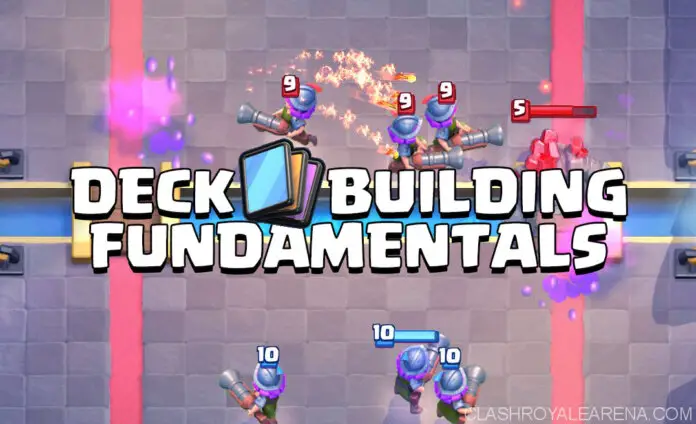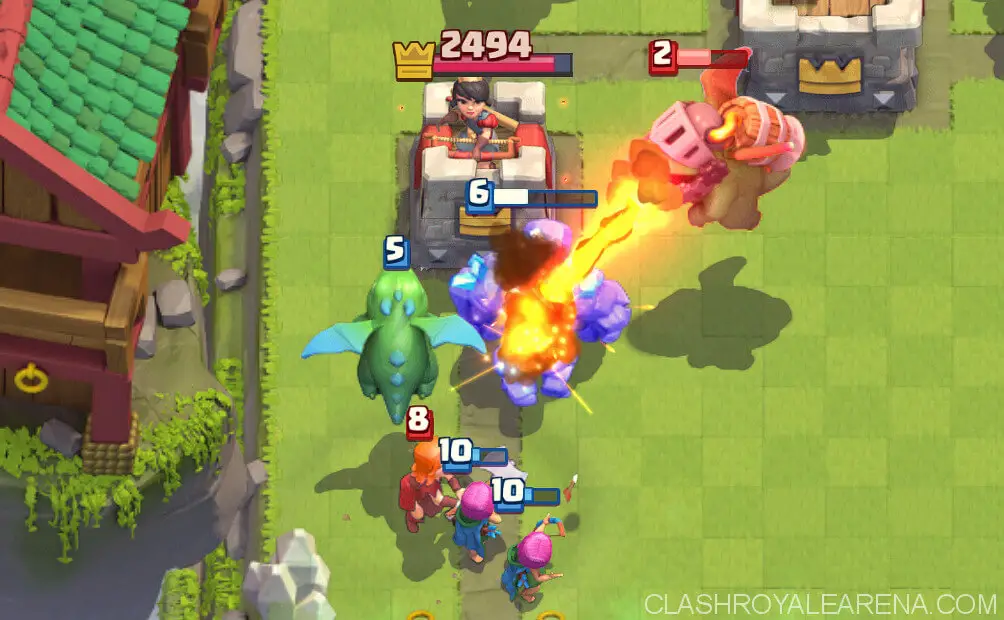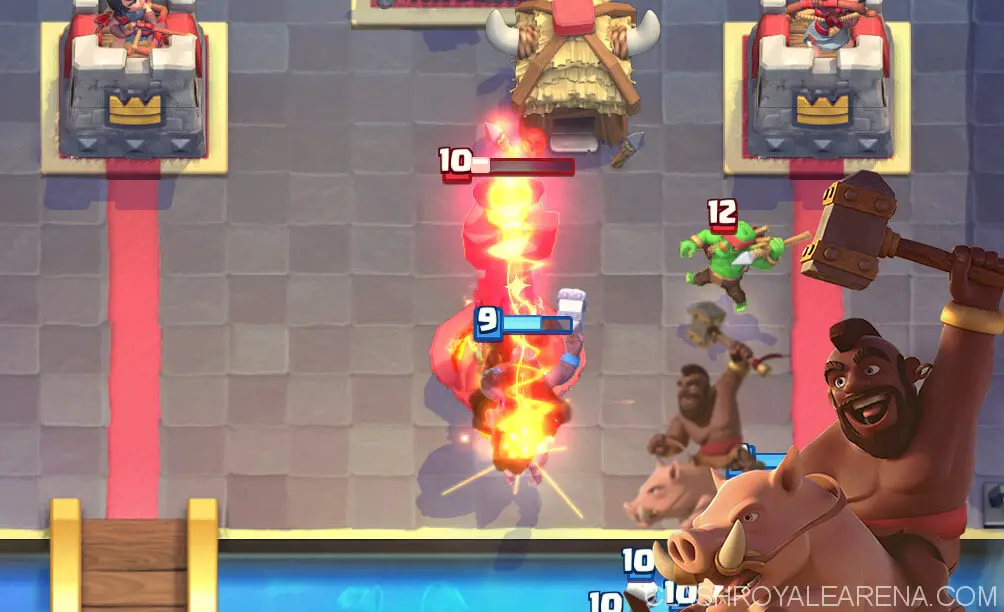Hello Fellow Clashers! I’m KairosTime and today I’m bringing you Part II to the “Strategy Guide to Clash Royale” with a Strategy Guide on How to Learn Every Deck. This is a guide for new players and experienced alike and is a precursor to my next guide which will be on How to build the Best Decks!
This written guide comes with a video guide that includes specific examples that I would recommend watching.
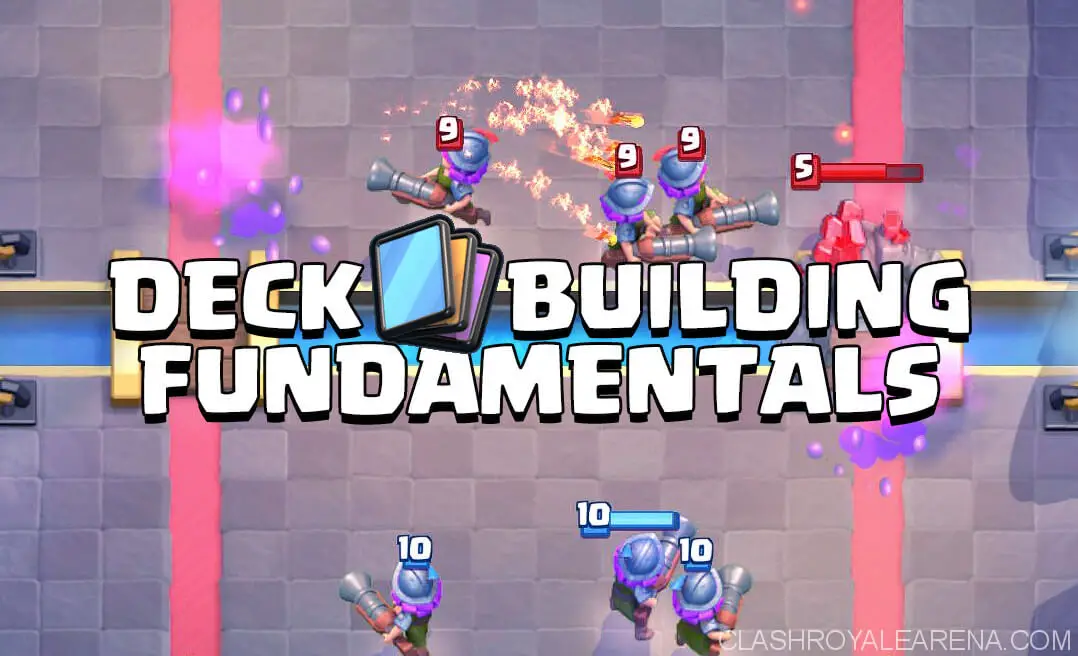
Deck Building Fundamentals
Table of Contents
In this guide, we’ll focus on 3 key topics:
- Mindsets
- 3 Different Deck Classifications
- Deck Examples
Understanding each of these Deck Classifications and how they work together will help you build decks that cater to your playstyle, utilize the strengths of your deck, and take advantage of the weaknesses in your opponent’s deck. It will also help you throw off your opponent’s mindset so they are forced to play the way you want them to rather than how they’d like to.
Important
It is important to understand that the principles in this guide are general guidelines and that there will be exceptions to every rule.
While most decks will fit into these classifications and will have certain strengths and weaknesses because of it, there are some decks that won’t fit or that could fit into different categories because of the way you play them.
By understanding these guidelines and learning when to be flexible with them, you’ll be one step closer to becoming a master of the game!
Mindset
Your mindset is your general plan to play your deck in order to succeed with it. While it’s important to be flexible with the way you play your deck, you’re typically going to have an offensive mindset and a defensive mindset.
- Offensive mindset – How you generally want to deal damage to the enemy tower
- Defensive mindset – How you generally want to prevent damage to your tower
If you can play your deck with the right mindset, or the right way, you will usually be able to throw your opponent off their mindset which will result in them playing their deck poorly. Learning to disrupt your opponent’s mindset plays an important role in becoming a master of the game!
It is important to realize that the mindsets of each deck type are good mindsets to have regardless of the deck you play, but the specific mindsets listed in the rest of the guide are typically how the respective deck type focuses on offense and defense.
Mindsets in this guide will be underlined and bolded

Classification 1 –  Speed
Speed
The speed of a deck is the first classification that we will be talking about.
While speed primarily depends on the average elixir of the deck, there are exceptions depending on the deck’s shortest cycle (The cost of your deck’s 4 cheapest cards).
While a deck may have a higher elixir cost because of 4 expensive cards, it may have 4 cards that are relatively cheap which means that this type of deck can actually be played faster than other decks that have a similar average elixir cost.
Also, if all of the cards in the deck are within 1 to 2 elixir from the average elixir cost, the deck might be a little slower than other decks with a similar average.
For the sake of keeping things simple for this guide, we’re going to be focusing only on Average Elixir Cost, but please be aware that your deck’s shortest cycle may make some decks faster or slower.
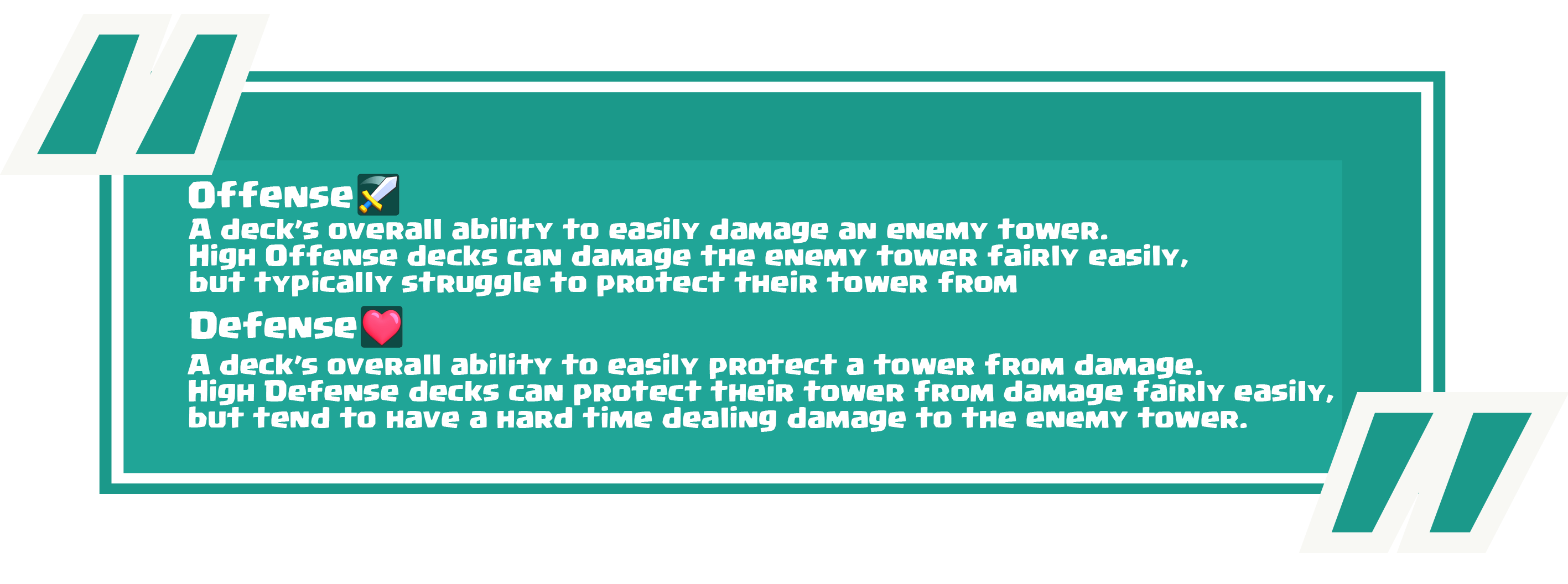
Fast Decks: 


Average Elixir Cost: 3.0 or lower
Offense: Strong – Fast decks, also called cycle decks, are typically very offensive and can easily get damage onto an opponent’s tower. When playing a fast-paced deck, your offensive mindset should be to quickly find out what your opponent’s counters to your win condition/s are and out-cycle counters so they have to try and defend with sub-optimal counters. Doing so will result in large amounts of damage on your opponent’s tower if they decide not to defend, or positive elixir trades that you can cash in at a later time if they do decide to defend.
Defense: Weak – Fast decks tend to struggle on defense because of the cheap cards in their deck that are easy to clear. The best defense for cycle decks tends to be a constant offense or a rush down the opposite lane of an enemy push. Unless your opponent is able to get good value out of a defense, your opponent will have a hard time keeping up with constant pressure
Medium Decks

Average Elixir Cost: Between 3.1 and 3.7
Offense: Decent – Being caught between the high offense of fast decks and the low offense of slow decks, medium-paced decks land right in the middle and are decent at damaging the enemy tower. As such, medium-paced decks give you the option of playing like a fast deck when your opponent’s deck is slower than your own, or playing like a slow deck when your opponent’s deck is faster. There will be times when out-cycling counters will give a medium-paced deck the advantage, and other times when building up a push will help you take the crown. While having the option of having 2 offensive mindsets is beneficial, it is important to know when to play fast and when to play slow. If you make the wrong decision and try to out-pace a fast deck or try to build up a push against a slow deck, you will likely lose.
Defense: Decent – Just like in Offense, Medium-paced decks must choose when it is better to defend like a Slow deck or a Fast deck. If you’re playing against a slower deck, it would be wise to apply constant pressure as a way to prevent your opponent from building up a push or even rush a lane. If you’re playing against a faster deck, using strong defenses will give you a good advantage. Learning when to play fast and when to play slow is an important factor in defending with medium-paced decks.
Slow Decks
Average Elixir Cost: 3.8 or higher
Offense: Weak – Slow decks, also called heavy decks, tend to have weak offense because they have a lot of cards that are more elixir heavy and it usually takes some time to get damage on the tower. To overcome the lack of a fast and strong offense, slow decks have the mindset of slowly building up a push that is so large that it simply can’t be stopped. It’s important to be aware of which cards are in your opponent’s deck so that you can either preemptively counter their counters, or so you can be prepared to counter their counters.
Defense: Strong – Slow decks have a lot of different options that can be used to prevent tower damage which makes them very good at preventing damage from landing on a tower. However, it is very important for slow decks to not over-defend so that support can still be added to the main offense. A good mindset for a slow deck would be to use highly defensive cards so it is difficult for the opponent to land a hit on the tower. Often, slow decks have to worry about an opponent rushing the other lane, so it is important for slow decks to have solid defenses that can stop a rush.

Classification 2 – Archetype
Most players that are reading this will already be aware of the classic 3 deck archetypes that were originally defined by The_RumHam in his “3 Decks of the Metagame” post on Reddit. Your Deck Archetype depends on the role of your deck’s Win-Condition and how you use your Win-Condition.
The 3 main Deck Archetypes are Siege, Control, and Beatdown.
In this guide, we will be looking at these 3 archetypes in a different light, and will be talking about the general Strengths, Weaknesses, and Mindsets of each of them.

Control Decks
 Win Condition Role: Primary tower destroyer up close
Win Condition Role: Primary tower destroyer up close
Examples: Hog Rider & Miner
Offense: Strong – Control decks tend to be able to have an easier time dealing damage to the tower than the other archetypes. That being said, most people are prepared to stop a push from a Control deck, and so it makes it very important to have the right offensive mindset of striking when the time is right. This may be when they don’t have the right counter to a certain card, or it may be when they don’t have the elixir to defend. In order to make this possible, it’s important for Control players to try and find every opportunity they can to get an elixir advantage so they can turn that into quick damage to an enemy tower.
Defense: Weak – Control decks tend to use offense as a strong defense because they typically use cards that aren’t as defensive as cards used in other deck archetypes. When it comes to playing defensively, control decks have the mindset of going for positive elixir trades so that they can continue going on the offense, thus preventing their opponent from having enough elixir to go on the offense.
Siege Decks
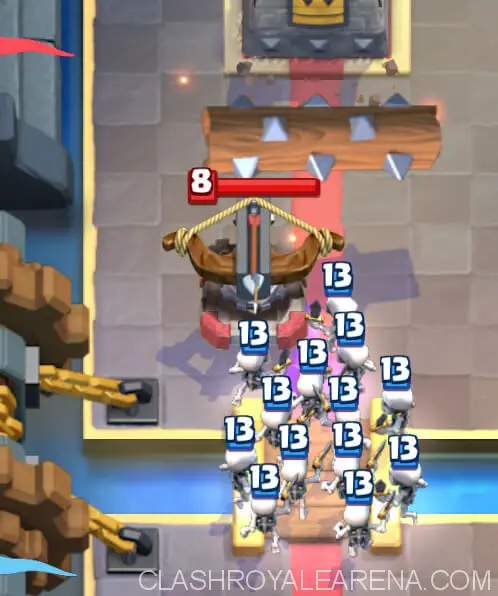 Win Condition Role : Primary tower destroyer from a distance.
Win Condition Role : Primary tower destroyer from a distance.
Examples: Mortar & Xbow
Offense: Weak – Siege decks don’t typically have a lot of ways to easily damage the enemy tower but rather rely on the sole power of 1 or 2 cards to damage the tower. This makes Siege decks have relatively low levels of offense when compared to the other archetypes. As such, the offensive mindset for Siege is to protect the win condition. If you can protect the win condition well enough, you should be able to use the offense of that 1 card to take an enemy tower.
Defense: Strong – Siege decks tend rely on very defensive cards to keep their win condition alive which means that they are strong on defense. In the case of the Mortar and Xbow, you can even use the win condition in the deck as an added defense by “Turtling Up”, which is a term used for when you place the Xbow or Mortar further back in the center of the arena as a way to apply defensive pressure on your opponent. The defensive mindset for Siege decks is to turtle up when you’re not ready to go on the offense and would rather deal with the opponent on your side of the arena where you have the advantage.
Beatdown Decks
 Win Condition Role: Protects support units that damage the tower
Win Condition Role: Protects support units that damage the tower
Examples: Giant & Lava Hound
Offense: Decent – Beatdown decks typically have a fair amount of offensive cards, but not as many as control decks do. Instead, Beatdown decks take advantage of having the right cards in their deck to take care of enemy counters on the enemy side of the arena. As such, it is important for Beatdown decks to find out which counters their opponent has for their deck, and build their push based on those counters by either preemptively adding the right support troops to the main push, or by being prepared to counter defenses with the appropriate spell. This mindset is called using the right support.
Defense: Decent – Beatdown decks tend to not be as defensive as siege decks, but also have a fair number of defensive cards to be used. In order to build up a proper push with the right support cards, a good mindset for a beatdown player to have is to use the tower’s health as a resource in order to build up enough elixir for the Beatdown push. If you don’t know what I mean by “use the tower’s health as a resource”, you will want to read my guide on “How to Manage Elixir”.
Strengths, Weaknesses and Mindsets
By using the 2 first deck classifications and organizing them like I have done in the chart below, you can learn a lot about these basic 9 different deck types.
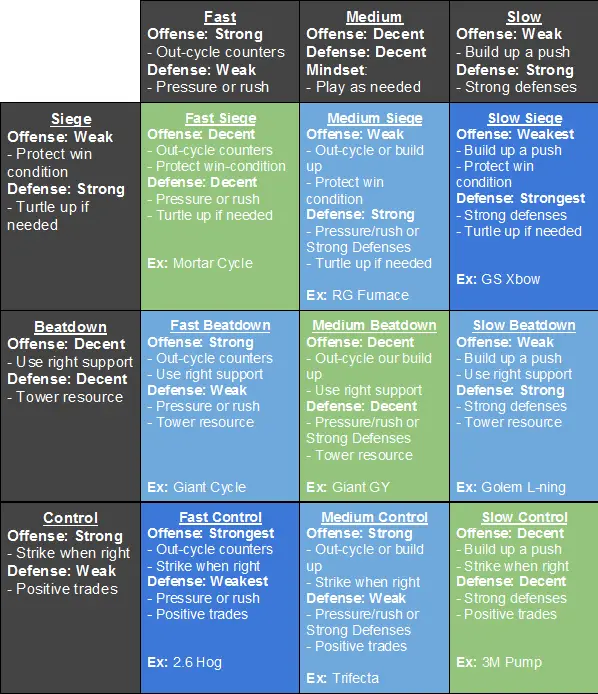
The first deck types I would like to talk about are the decks that are in Green. These are the decks that are decent at both offense and defense. For example, Siege decks tend to be weak on offense, but fast decks are strong on offense. By making a Fast Siege deck, you have a deck that is good at both defending and going on offense but may struggle when facing another deck that is more offensive or more defensive. This fits for both Medium Beatdown decks, and Slow Control decks.
Next, I would like to talk about the decks in Light Blue. Because of where these lie on the chart, they will be strong in one way and weak in another way. For example, both Fast Beatdown decks, and Medium Control decks have strong offenses and weak defenses. On the other hand, Medium Siege and Slow Beatdown decks have a weak offense and strong defense. These decks try to use their strengths to overcome their weakness by focusing on following the mindsets of their classifications.
The last decks I would like to mention the decks in Dark Blue. These decks are on the extremes of this chart and are the strongest in one way, and weakest in the other way. Fast Control decks focus on constantly applying pressure on their opponent but have a difficult time defending if their opponent builds up a push. On the other hand, Slow Siege decks tend to be able to defend nearly any push, but have a very difficult time doing enough damage to a tower to actually take it down.
In my experience, all of these deck types can be very strong if you play them the right way, and you have the right mindset. As the meta shifts due to balance changes and new card additions, different deck types will become stronger or weaker, and more or less popular. If you are good at playing a specific type of deck and would like to expand your ability to a different deck type, it might be a good idea to start with a different deck type that has similar characteristics to the one you’re good at playing.
If you would like examples of each of these deck types, I would recommend watching my corresponding video guide to this guide.
Classification 3 – Utility
On top of these 2 different deck classification types, there is a 3rd deck classification which adds another level. This 3rd classification has to do with a 3rd fundamental principle called “Utility”.
We will be covering the two different types of decks with regards to utility: Unity and Balance.
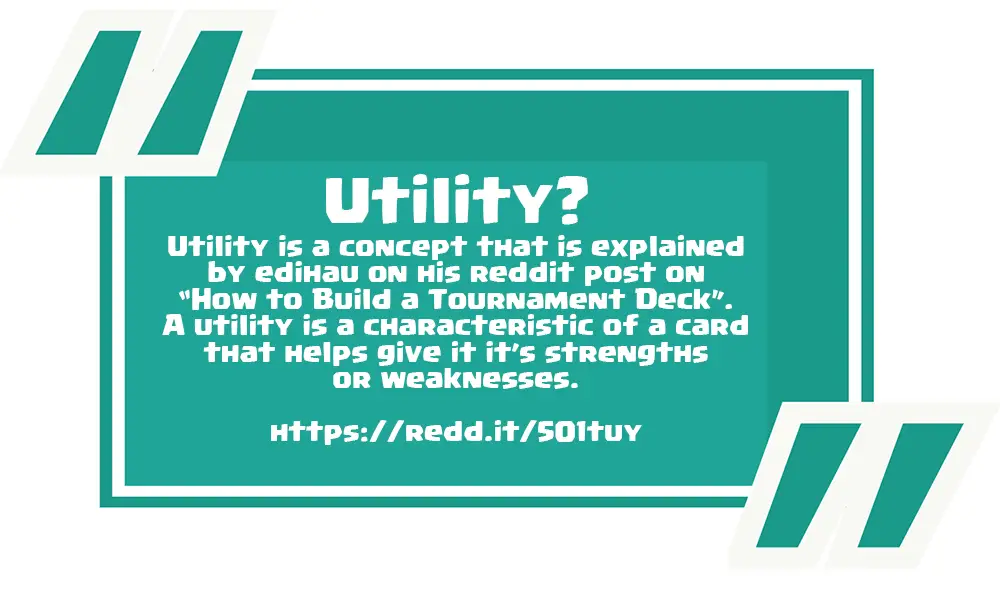
Unity Decks
Unity Decks focus on 1 utility and fill that deck with that utility, while using 1 or 2 cards in the deck to overcome the weaknesses that utility has. These decks are built around overwhelming your opponent with the 1 utility until they can’t defend that utility any longer and you take their crown. These decks are extremely strong against some decks, but are very weak against other decks.
Unity Decks play around the main 1-2 counters their opponent has to their utility and once those counters are no longer a threat, they strike and that usually leads to the downfall of an enemy tower. Unity Decks are very strong if their weakness is unpopular in the meta or if the counters aren’t too difficult to overcome.
Some utilities that have been used to make Unity Decks in the past are:
- Flying – LavaLoon Decks
- Swarm – Spell-Bait Decks
- Spawner – Zoo or Spawn Decks
- Structure Targeting – Multi-Win Condition Decks
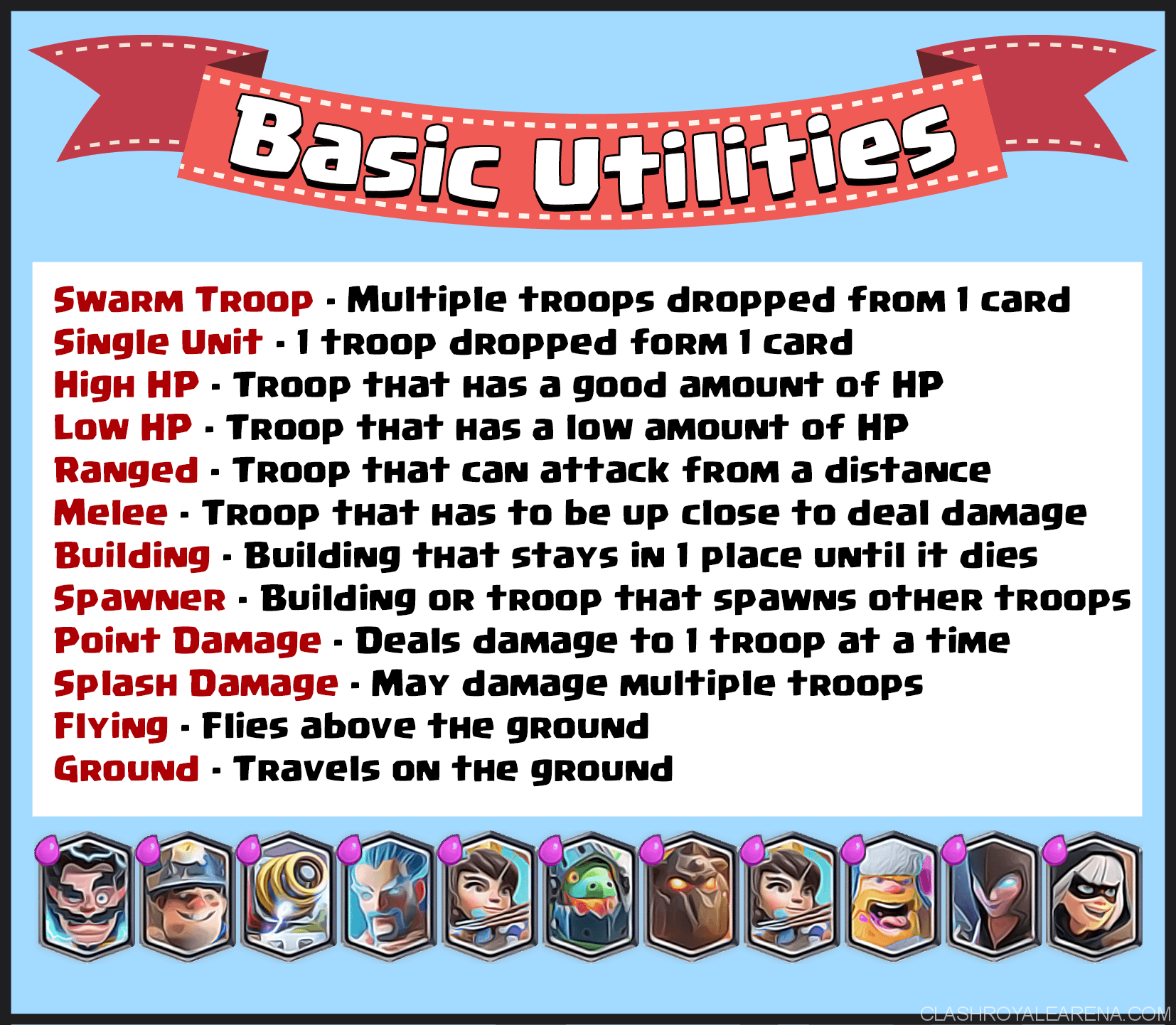
When facing other Unity Decks , the mindset is to out-utility the opponent by creating the biggest threat.
The simplest example of this is a Flying Unity Deck that has no anti-ground cards facing a Ground Unity Deck that has no anti-air cards.
In essence, the first person to realize what’s going on and can take down the King’s tower the fastest will win.
While battles are way more complex than this, the principle stands true when two utility decks are facing each other.
Balance Decks
While Unity decks focus on 1 utility, Balance Decks are built around using multiple or all utilities.
By having an answer to everything, Balance Decks tend to be decent at facing all decks.
That being said, they can struggle against Unity Decks if they only have 1 or 2 counter to the utility that the Unity Deck has focused on.
The mindset of Balance Decks is to target enemy weaknesses and to out-skill enemy strengths. If you can do this with a Balance Deck, it will be difficult for your opponent to beat you.
Conclusion
With these 3 Deck Classifications, that makes a total of 18 basic deck types in the game. Whether you want to become Specializer who masters one or two of these Deck types and gains so much skill that no one can beat you, or a Generalizer who gets great with them all so no one can stand in your way with your complete understanding of the game, you now have the understanding of every Deck Classification which will help you become a master in The Arena.
Thanks so much for reading this guide! If you’re interested in learning more, make sure you subscribe on my YouTube Channel so you can be the first to see my guides. If you have any questions, feel free to leave them as comments on my video and I’ll get back to you as soon as I can!
Ticking By,
KairosTime

